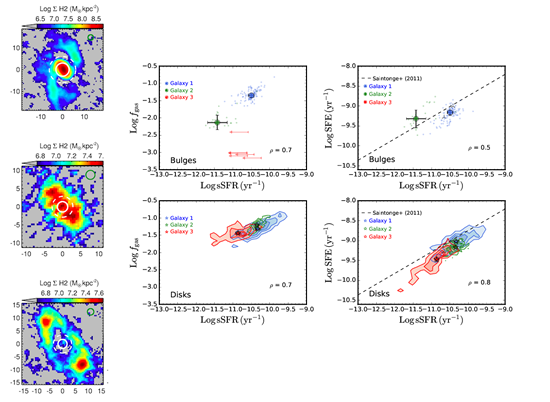研究成果藝廊 > 阿塔卡瑪大型毫米及次毫米波陣列計畫(ALMA)
研究成果藝廊
阿塔卡瑪大型毫米及次毫米波陣列計畫(ALMA)
| The role of molecular gas in suppressing star formation in galaxies |
|
圖片來源: Lihwai Lin, Hsi-An Pan, Bau-Ching Hsieh, Pei-Ying Hsieh

Left panels: The distributions of molecular gas for three MaNGA-selected green valley galaxies (from top to bottom: Galaxy 1, Galaxy 2, and Galaxy 3) based on ALMA CO observations. Middle and right panels: The gas fraction (middle panels) and the star formation efficiency (SFE; right panels) as a function of specific star formation rate (sSFR). The dashed lines show the COLD GASS results based on a sample of galaxies with secure CO detections (see Table 1 of Saintonge et al. (2011)). The small dots in the upper-right two panels represent spaxels located in the bulges. In the bottom-right two panels, the contours represent the distributions in the disks. The solid circles and stars show the median values of the bulge and disk regions, respectively. The red arrows in the top-left panel indicate the upper limits for Galaxy 3. The Spearman’s correlation coefficient � is also shown in the lower-right corner of each panel. The figure is taken from Lin et al. (2017, ApJ, 851, 18).
|
| Galaxies show bimodal distributions in terms of their star formation activities, one named the star-forming sequence and the other named the passive population. Galaxy in between, the so-called green valley galaxies, are likely in the transition phase that migrate from the active star-forming to the quiescent phase and therefore they are ideal targets to probe the quenching mechanisms that shut off the star formation in galaxies. Combining the ALMA and MaNGA resolved observations, we connect the molecular gas abundance and their star formation efficiency to the star formation rate for three green valley galaxies. Our pilot study shows that the suppression of star formation in the bulges is primarily driven by the low gas fraction, whereas both the reductions of gas fraction and the star formation efficiency are responsible for lowering the star formation rate in the disks. These results are published in Lin et al. (2017 ApJ, 851, 18). |
 asiaa.sinica.edu.tw 媒體連絡: epo
asiaa.sinica.edu.tw 媒體連絡: epo asiaa.sinica.edu.tw
asiaa.sinica.edu.tw